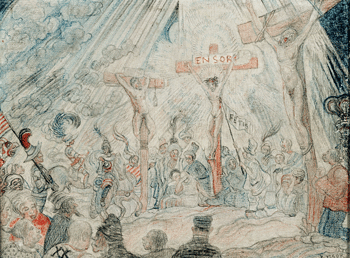Can you remember when, as a teenager, you might have ridiculed a classmate because he was different than you? Perhaps you were good most of the time; I wasn’t, and I can remember it. Oftentimes we mock what seems different or confusing. Greater understanding doesn’t come for a kid when he makes fun of something; nevertheless, he does it because he’s afraid of what he doesn’t know. Poking fun is easier than asking sensitive questions.
An artist’s mockery may open up paths of insight for those of us who view, read, watch or listen. Modern art is especially good at this: it forces us to pay attention to satire. Satire doesn’t bashfully hide among Andy Warhol’s soup cans, nor do John Cage’s intentions subtly lurk in his piano composition, 4’33.” Unlike Mona Lisa’s smile, these modern artists are eminently scrutable.
I recently spent an afternoon at the special exhibit of James Ensor’s work at the Museum of Modern Art in New York City (through Sept. 21). His way of ridicule seems, at times, a profound way of exploring the hidden meanings of those things he feels are most different from himself. But, like the boy who teases the girl on the playground that he’s most interested in, the great artist pokes fun at the most important images and symbols of Christian faith. Of both we say, “Methinks thou dost protest too much.”
Ensor was Belgian, and so almost by definition he stood on the outskirts of European culture, and outside the inner sanctums of power in the art world. Also, he didn’t seem to care much for influencing others. A mostly private man, Ensor nevertheless became one of the pivotal figures for the flowering of two movements in art: Expressionism and Surrealism.
James Ensor was born in 1860, and by 1875 his family was too poor to support him any longer. So he began to train with local painters much as William Blake apprenticed to an engraver a century earlier in England. Also like Blake, Ensor developed his unique vision and palette early, and the subjects he chose were idiosyncratic: Christ’s entry into Jerusalem, skeletons fighting over a pickled herring, the temptations of St. Anthony in the desert, puppetry, and portraits of friends.
Ensor was obsessed by religious imagery—that much is clear when you look at many of his pictures at once. (The MOMA exhibit is, marvelously, entirely on-line, for those who are far from New York.) He had a wicked sense of humor, much like I’ve always imagined Adam or Job must have had; when you’ve lost a great deal, you laugh, cry, settle or become sardonic. Thank God that when Ensor felt his faith slip away, he took up his brushes.
The etchings and paintings can initially appear to be scandalous, and his contemporaries certainly looked at them that way at times. Yet behind the first impressions is a man struggling to understand something difficult. It reminds me of how a Christian mystic like Bede Griffiths once found a kindred spirit in D. H. Lawrence, feeling that a man couldn’t write about love of any kind so accurately without understanding something about divine love. Similarly, Ensor has always had his followers who embrace the strange vision he brings to things religious.
The torments of Jesus Christ were one of his obsessions. For four years, still early in his career, Ensor etched and painted dozens of images of Christ being abused by sometimes faceless, and sometimes horrifyingly full-faced, perpetrators. The effect is macabre and even grotesque, but it also produces pity; they are like Michelangelo’s “Pietà” for urban moderns. These paintings—such as the magnificent “The Entry of Christ into Brussels”—are Ensor’s commentary on the inhumanity of humans.
He mocks the mockers, and it’s not clear whether he does this because he himself felt abused by his detractors (the ultimate revenge against the school bullies), or if the painter identified with Christ in a more spiritual way. Take, for instance, the painting “Calvary” from 1886. Ensor placed his own surname on the crossbeam of the cross that holds the Savior. The MOMA catalog describes this as “one of Ensor’s earliest self-representations of Christ.” The centurion stands in clown garb, floppy hat and all, as if he’s just walked out of a circus scene and into this horrific one. True to the Gospel story, he possesses a long sword that is piercing the side of Christ; a banner hangs from the sword identifying the clown-centurion as a Belgian art critic that Ensor disdained. This is like Dante assigning his enemies to the circles of hell.
Did the painter feel sorry for himself? Or was he attempting to understand the gross meaning of the key event in the origin of Christianity? It doesn’t much matter to me. Regardless of his intention, the effect of Ensor’s art on the viewer can be powerful. To a believer, these are also profound statements about who Christ is. For example, in the etching from 1886, “Christ Mocked,” the sharp but inchoate lines of the crowd adds an emotion to the air that, despite the black and white of the medium, is palpable. His “Man of Sorrows” self-portrait is both a horrifying painting to look at and a powerful reminder of St. Paul’s words, “Living is Christ and dying is gain.”
Ensor was preoccupied with death. He painted self-portraits as a skeleton, which can be hilarious in the same way that an elderly person can be confident of both mortality and eternity, with great humor. I laughed out loud in the exhibit hall in front of the etching, “My Portrait in 1960”—an exhausted bundle of bones with a few scraggly hairs on top of his skull. (Ensor died in 1949 at the age of 89.)
James Ensor called himself an atheist, but he’s my kind of atheist: a man who is fighting inside himself, perhaps wanting but unable to believe, knowing well the line between good and evil in his soul, but ultimately coming up short. I can’t help but compare him to Graham Greene, who late in life took to calling himself an “atheist Catholic.” Perhaps this only means that the older we get, the less we’re sure of. It’s the struggle that counts. Imagine the atheist artist who could create the self-portrait from 1888, “Demons Tormenting Me.” This isn’t a Dante after all; Ensor found himself in hell.
View a slide show of James Ensor's art work.









Art is something special that everyone can see, admire, and even regard them as a valueable object. it is still right until we take the realisation that the ancient or the modern pictures originally exist in the current stages of time. the artist with the famous name -Jon M. Sweeney turned out in the light of the lectural situation of the world.behind the hidden and mysterious smile is the whole artical eagle at the sight of human well- being.they bring the exclusive honor of the supreme preference back to the watchers. the exhibition gave the expansive access to the immense inspiration for the audience. we can find it especially strange to pick out the feeling. in the impression of skeletons and the ambiguos shapes comes the people as a complex emotion along with the thinking of the history and the thorough interaction for the normal disorder like the rules of the nature.that is so great to wonder whether such the spectacular landscapes is constant previously or not. but above all, conception of the forms of the picture with the genres in drawing the portraits, image, ....and the certainty that the colour of art will compress in everybody's heart and in the memory as well as following the streams of time, of historical decades.